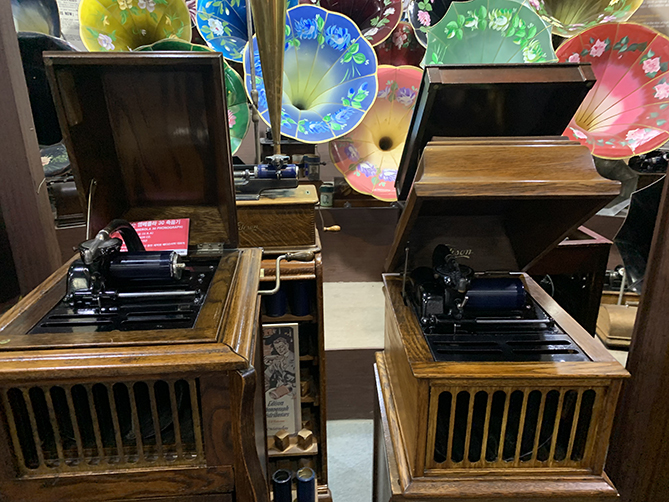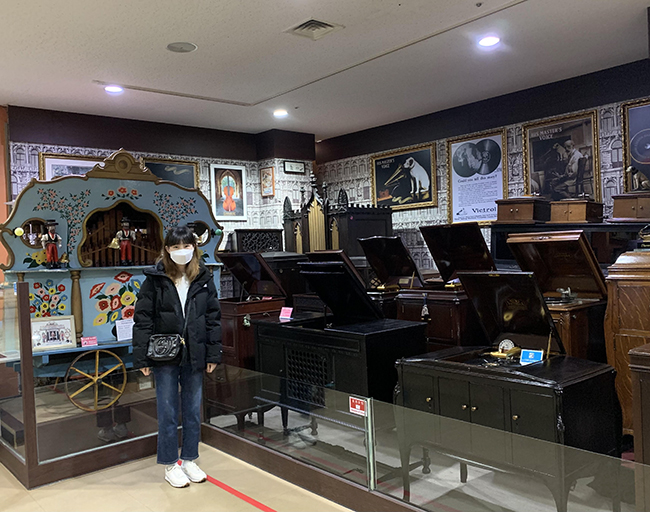Last Christmas, I found a thin square box under the tree. It was a record by my favorite artist, Crush, and was given to me by my father. After reading the book The Secret of the Record by Young-ho Kwak, my father started to buy and collect records, record players, amplifiers, and other types of audio equipment. Listening to records inspired me. Digital music is common these days, so there aren't many opportunities to listen to analog forms of music such as records. Taking this opportunity, I, as someone who usually enjoys listening to music, started to look into how sound was recorded on records and when records were invented.

According to the book, The Secret of the Record, by Young-ho Kwak, I was able to find that Thomas Edison invented the first sound recording and playback device in 1877. It was a phonograph with grooves that produced sound from the physical vibration made by the needle tracking over it on the surface of the record.So, I went to the Charmsori Gramophone and Edison Science Museum in Gangneung to find out more. This museum displays various kinds of gramophones and phonographs, including Edison’s first phonograph, called “Tinfoil,” and 200 phonographs from Edison’s company.

Edison’s record for phonography was designed with a structure that allowed it to record and play good quality sound. The silver phonograph record was not in the form of a flat disk as it is now, but in a cylindrical shape, with a screw-shaped groove engraved on its surface. Also, phonographs of the past had trumpets of different sizes and designs. The sound produced by the physical vibrations was so small that a trumpet tube had to be used to amplify the sound. Edison’s cylindrical phonograph record had the properties necessary to provide stable sound quality thanks largely to the grooves that were rotated at a constant speed.

At the Charmsori Gramophone Museum, I was able to see the entire history of the gramophone. After listening to the staff describes the museum exhibits, I took notes and did some research. I learned that in 1887, Emil Berliner invented a new device that did not infringe upon Edison’s patent: the gramophone. This device recorded sound on a flat, round disk rather than a cylindrical one. It also had a trumpet tube attached to amplify the sound. After the electricity-powered gramophone was developed, speakers were installed instead of trumpet tubes. Today, records are all disk-shaped. So, I wondered what happened to Edison’s cylindrical record.

Edison’s phonograph by Edison had excellent sound quality but failed commercially. Berliner’s Gramophone, however, had the great advantage of being able to easily duplicate large numbers of records, although the sound quality was relatively poor. The cylindrical record was harder to replicate than the disc-type record due to its structure and much more fragile. Furthermore, the cylindrical record could not be played many times due to the damage caused to the grooves over which the vertically vibrating metal needles passed.
Berliner's Gramophone gained popularity with the public as its sound quality increased through steady improvements, becoming the main player of the phonograph era. According to Kwak’s The Secret of the Record, Enrico Caruso's opera Aria, recorded in 1902, was the first major hit in the history of classical music. However, if Aria had been recorded on Edison's phonograph, its distribution would have been limited, and few people around the world would have been able to hear the opera.
Records, which seemed to disappear completely after 1990, are drawing attention from music lovers again in the 21st century. New records are being planned, produced, and sold in record shops and online stores, and tens of thousands of records are traded daily on auction sites. Recently, three sets of records of all of Johanna Martzy's Bach's Unaccompanied Violin Sonata and Partita, released on the British Columbia label, sold for tens of millions won.
Nowadays, people download and listen to digital music files using computers or listen to music using streaming services on their smartphones rather than sit at home or at a cafe and listen to music in a calm and relaxing atmosphere. Although listening to music with a record is definitely a hassle and a lot of work, the record provides a kind of comfort and satisfaction that other types of more convenient media cannot replicate. Truly good music should be comfortable. I hope that more of us take the time to listen to music as a means of enjoying the thrill of deep-felt emotions and gaining new energy!

Haram Yoon
11th grade - Junior
Holy Trinity Catholic High School (TX)

